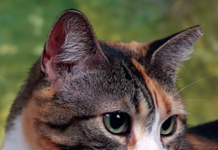This occasional series explores the reasons for cats’ often intriguing behavior. If you would like to suggest a topic, please write CatWatch Editor, 800 Connecticut Ave., Norwalk, CT 06854, or email catwatcheditor@tufts.edu.
You cringe as your acrobatic cat maneuvers through an open window and accidentally falls or jumps to freedom in the great outdoors, landing feet first. While it seems as if cats almost always land on their feet, the truth is that they don’t always land safely. Internal injuries can occur and owners can sometimes overlook them.
“Most cats do land on their feet when they have had time to reorient themselves,” says Andrea Johnston, DVM, a specialist in internal medical and Clinical Instructor in Small Animal medicine at the Cornell University College of Veterinary Medicine.
A study backs her up: Ninety percent of 132 cats seen at the Animal Medical Center in New York survived after falling from sometimes great heights, though most needed treatment, according to a study published in the Journal of the American Veterinary Medical Association.
Cats in free fall immediately go about righting themselves in a race against the clock. It’s as if a universal joint sat at the core of their bodies. The cats right themselves from front to back, righting the head and front feet, followed by the back feet.
Cushioned Disks. The late James R. Richards, DVM, Director of the Feline Health Center, explained the possible reason in a column for the Cornell Center for Materials Research: “Cats are able to rotate their supple spines more than many other animals and can twist their bodies to a much greater extent. Cats’ vertebrae — the spools-on-a-string-like bones in the back — are very flexibly connected and have especially elastic cushioning disks between them. This limber spine allows cats to perform their elegant and graceful acrobatic feats.”
Surviving a fall is one thing, but thriving is another if treatment isn’t sought. That New York study found that 90 percent of cats studied suffered chest trauma. About seven out of 10 cats had bruises in their lungs, resulting in their lung tissue being filled with blood and other fluids. Nearly as many had a collapsed lung, causing air to collect abnormally in the space between the lung and chest wall.
Some cats suffered facial trauma (57 percent), broken limbs (39 percent) and dental fractures (17 percent), among other injuries. Nearly four in 10 needed emergency life-sustaining treatment. Only 30 percent of cats in this study didn’t need treatment after a veterinary examination.
So the myth of the cat landing safely on his feet is often just that — a myth. Oddly enough, falling from a second floor or other lower stories isn’t necessarily safer. Pets who fell from higher floors did better than those who fell from between five and nine stories.
“Perhaps it’s because cats falling from greater distances have more time to right themselves,” says Joel Weltman, DVM, a Cornell third-year small animal emergency and critical care resident who completed his internship at the Animal Medical Center.
When cats fall from heights of at least two stories, it is called “high-rise syndrome and it isn’t unusual in an environment like New York City,” Dr. Johnston says. The 132 studied cats in New York all arrived at the AMC clinic in a period of five months. Meanwhile, ASPCA.org notes that Bergh Memorial Animal Hospital in New York sees about three to five high-rise syndrome cats a week in warmer months, when people leave windows open.
If your cat suffers a fall, seek immediate help. “This is a case where you should always seek veterinary care,” Dr. Johnston says, adding that injuries like bruises on the lungs may go unnoticed initially, but then become life-threatening in a matter of hours. ❖



